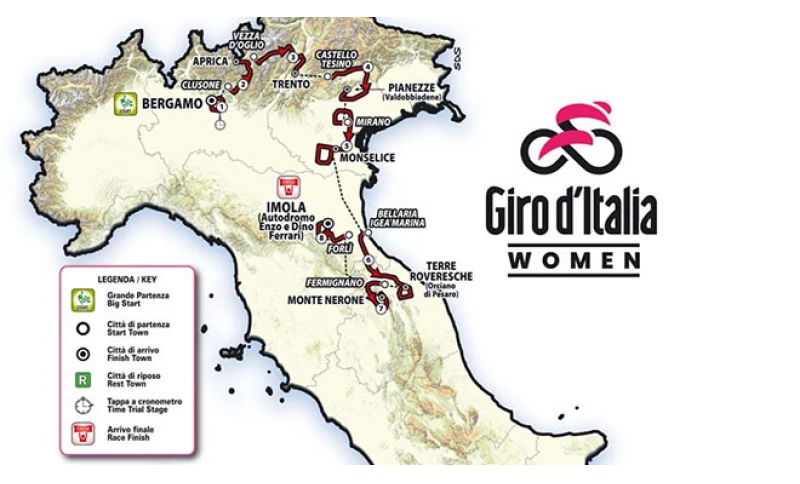

THE ROUTE
939.6 km and 14,000 meters of elevation gain (over 1000 more than the previous edition) featuring an individual time trial, two flat stages, three medium mountain stages, and two high mountain stages.
As in 2024, a time trial will kick off the competition in 2025. The 13.6 km on the roads of Bergamo will provide a first glimpse of the general classification. The athletes aiming for the final Pink Jersey will need to pay attention to the second stage, Clusone-Aprica, while the Vezza d'Oglio-Trento could represent the first chance for the fast wheels, despite crossing the Tonale Pass, the Alfonsina Strada Peak of this edition at 1883 meters.
The first half of the Giro d'Italia Women will conclude with Castello Tesino-Pianezze (Valdobbiadene), the first uphill finish of this edition. The final climb saw Fabiana Luperini's first success in the Pink Race in 1995.
The race will restart in Veneto for the fifth stage, completely flat, from Mirano to Monselice, the last respite before a decidedly tough final trilogy. The Bellaria-Igea Marina-Terre Roveresche (Orciano di Pesaro) will be a definitely undulating stage with a classics-style finale, preceding the second uphill finish at Monte Nerone. The final climb, with average gradients over 8%, is a novelty for the Pink Race.
Grand finale on Sunday, July 13th in Forlì-Imola, a stage with 2200 meters of elevation gain that will reprise the 2020 World Championships circuit with the climbs of Mazzolano and Cima Gallisterna.
THE STAGES
STAGE 1, BERGAMO-BERGAMO TUDOR ITT, 13.6 KM
Individual time trial entirely within the city. Starting from Chorus Life on wide and straight roads interspersed with U-turns and short half-curves. Passage towards the city center with a brief and light climb to graze the upper city and then descend to the finish at Sentierone.
STAGE 2, CLUSONE-APRICA, 99 KM
Stage divided into two parts, the first descending to Lovere followed by the second with a slight and constant ascent. Crossing the entire Val Camonica to Edolo and then climbing towards Aprica from the old road to Corteno Golgi. The route presents no real difficulties except for a brief steep section at Santicolo a few kilometers from the finish.
STAGE 3, VEZZA D'OGLIO-TRENTO, 124 KM
First sprint of the Giro. Challenging start with the climb of Tonale Pass (Cima Alfonsina Strada) followed by a very long descent crossing Val di Sole and Val di Non. After Mezzolombardo, the race continues through vineyards with slight undulations until crossing the Adige River, heading towards the finish in Trento.
STAGE 4, CASTELLO TESINO-PIANEZZE (VALDOBBIADENE), 156 KM
Stage with uphill finish after a long series of ups and downs in the Belluno area without truly calm sections. Very articulated stage both altimetrically and planimetrically. Descending into Val Cismon, skirting Feltre and traveling along the base of the Bellunese Dolomites to Belluno, circling Nevegal to tackle, after leaving Santa Croce Lake and Vittorio Veneto, the Muro di Cà del Poggio. Followed by a section through the UNESCO Prosecco territories up to the final climb of Pianezze (11.2 km at 7%).
STAGE 5, MIRANO-MONSELICE, 108 KM
Last quiet stage before the final trilogy that will determine the Giro classification. Completely flat stage. Departure from Mirano and route without particular difficulties, except for traffic obstacles, until the outskirts of Monselice. Crossing Venetian and Paduan zones not covered by the Giro for many years. Passing through Mira, Dolo, Piove di Sacco, and Conselve. Final 16.4 km circuit always flat on wide roads at the foot of the Euganean Hills.
STAGE 6, BELLARIA-IGEA MARINA-TERRE ROVERESCHE (ORCIANO DI PESARO), 144 KM
Very dynamic stage after a brief flat start. Reaching the Romagna Apennines, climbing San Marino and then heading towards Pesaro province, scaling a series of more or less short climbs including Mondaino, Monteciccardo, and Beato Sante. Passing through Cartoceto, Saltara, and the steep section of Villa del Monte before the final climb leading to the first passage at the finish. Approximately 15 km circuit with the climb to the finish through Mondavio.
STAGE 7, FERMIGNANO-MONTE NERONE, 157 KM
Mountain stage composed of a crescendo of difficulties without true breathing sections between them. The first of continuous ups and downs leads after Apecchio to the slopes of Monte Nerone, scaling its first part up to Pian di Trebbio. Then descending towards Pianello to successively climb the short ascents of Moria, Passo la Croce, Valico di Sitria, and Valico di Croce Avellana. Finale through Frontone, Cagli, and Secchiano to tackle the climb towards Pian di Trebbio where the last 8 km begin, very demanding (over 8% average) leading to the finish.
STAGE 8, FORLI'-IMOLA (ENZO AND DINO FERRARI RACETRACK), 138 KM
Final half-mountain stage very challenging. After a brief initial flat section, entering what was the 2020 Cycling World Championship circuit to be covered 4 times with the demanding climb of Cima Gallisterna and the climb of Mazzolano with passages and final finish inside the Enzo and Dino Ferrari Racetrack.
